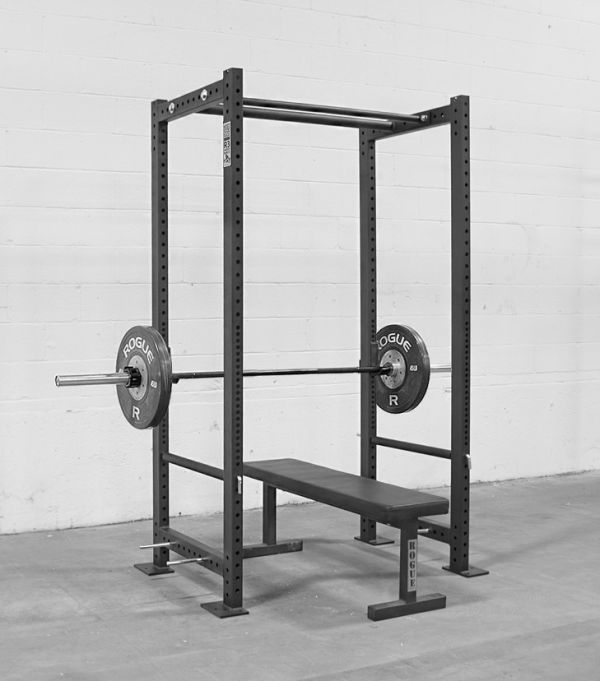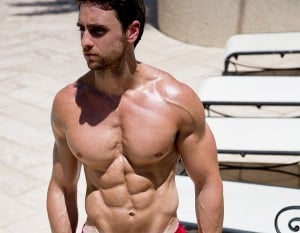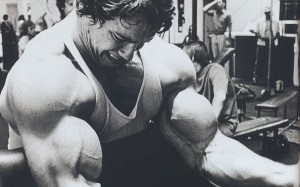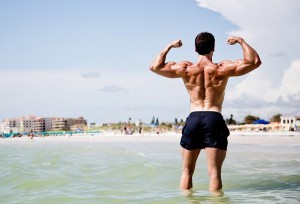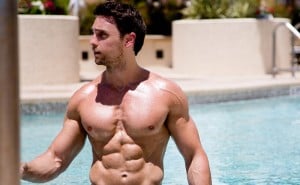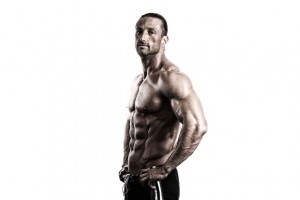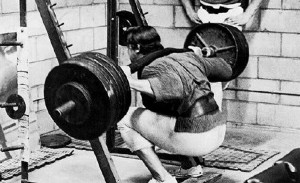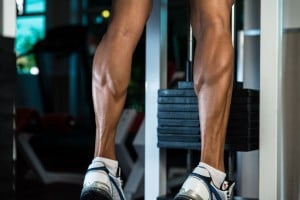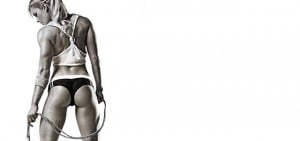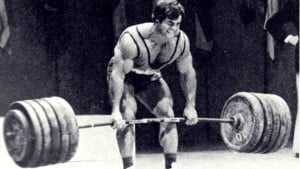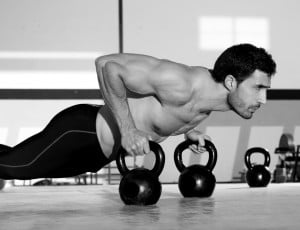If you’re hitting the weights regularly but neglecting your leg workouts, I want to warn you of what is to come…
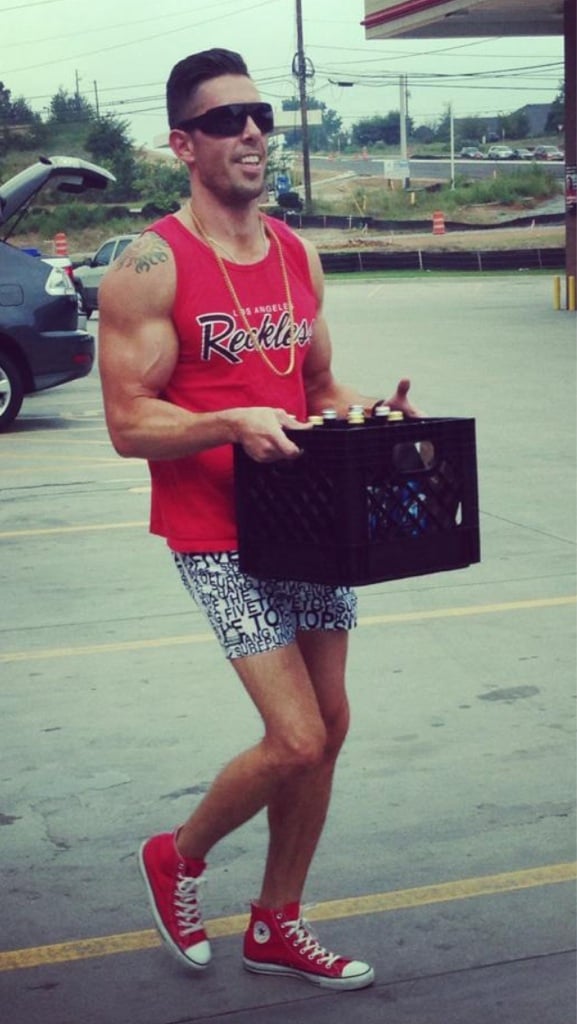
Yikes.
In all seriousness, I understand the temptation to skip legs day.
I used to do it all the time and, well, looked more like the guy in the picture above than I would have wanted to admit.
But!
I’ve repented and changed my ways and while my legs are still lacking the separation and density that comes in time, I’ve finally caught them up enough to where they’re not a glaring weakness…
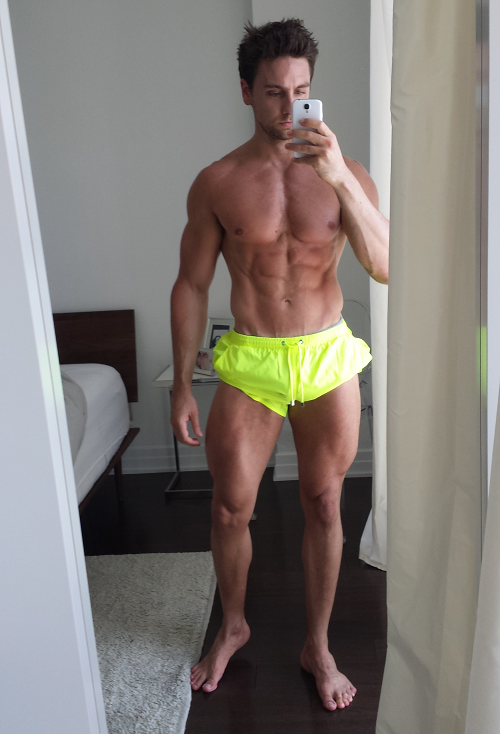
I’ve also…gasp…come to actually enjoy my leg workouts.
Anyway, the bottom line is it takes quite a bit of time and work to build an impressive set of legs and it’s not a simple matter of DOING MOAR SKWAATTZZ!!1!!
Yes, squat exercises are a vital part of leg training, but if that’s all you’re doing, you could be getting more out of your time in the gym.
So, in this article, I’m going to share with you what I’ve learned about building big, strong legs, including…
- The most effective way to program your leg training
- The best leg exercises and how to do them
- My favorite leg workout that you can put to use right away
- And more…
Let’s get started!
- Understanding the Anatomy of the Legs
- The Simple Science of Effective Leg Training
- The Best Leg Exercises
- The Ultimate Leg Workout
- What About Supplements?
- Want More Workouts?
- What do you think of these leg exercises? Have anything else you'd like to share? Let me know in the comments below!
Table of Contents
Understanding the Anatomy of the Legs
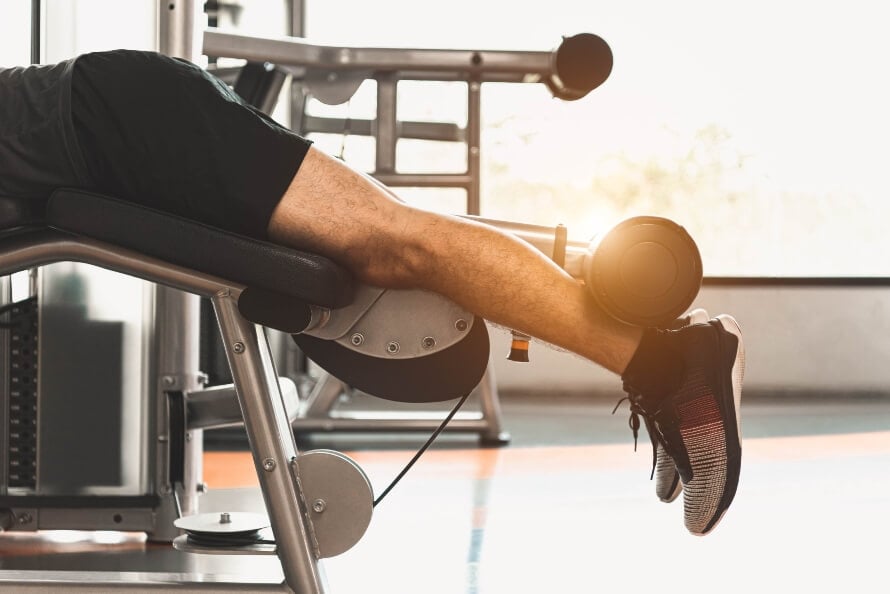
Before we get to the training, I’d like to quickly review the major muscles of the leg so we know what we’re looking to develop.
The quadriceps is a group of four muscles that comprise the bulk of the muscle on the front of the thigh. The four “heads” of the quadriceps are:
- The rectus femoris
- The vastus lateralis
- The vastus medialis
- The vastus intermedius
Here’s how they look:
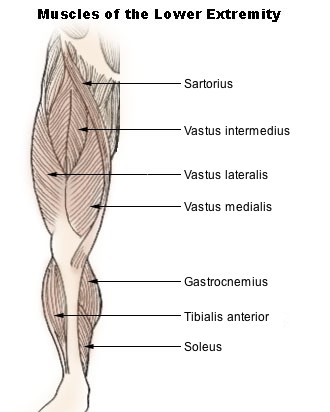
The back of the leg is dominated by three muscles that comprise the hamstrings:
- The semitendinosus
- The semimembranosus
- The biceps femoris
Here’s how they look:
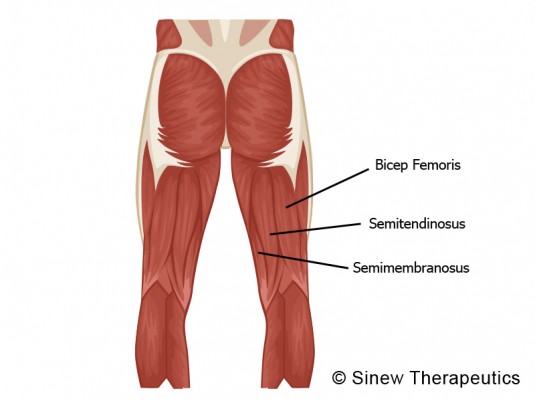
And last but not least is the calf, which is comprised of two muscles:
- The gastrocnemius
- The soleus
And here’s how they look:
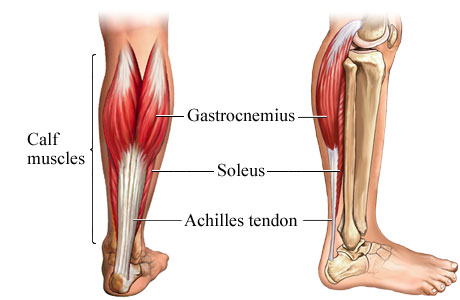
As you can see, the bulk of the calf is the gastrocnemius muscle, and the soleus lies under it.
So, those are the major leg muscles that we’re concerned with in terms of visual development.
There are quite a few smaller muscles that will greatly affect our ability to properly train these larger muscles, but we don’t need to review each of them.
By following the advice in this article, you will develop them along with the larger groups.
The Simple Science of Effective Leg Training
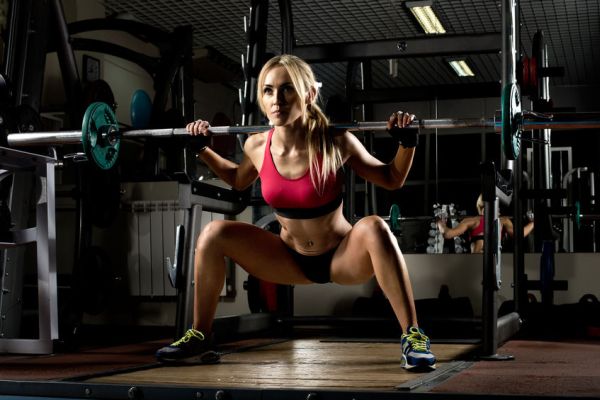
The three biggest mistakes most people make in their leg workouts are:
1. Doing the wrong leg exercises.
Many people focus too much on machine and isolation exercises, which should be seen as supplementary work, not the core of your leg workouts.
2. Squatting incorrectly.
And I’m not just talking half-reps. There are plenty of other common mistakes such rounding the lower back, excessive “buttwinking,” and bowing the knees in.
3. Doing too much high-rep training.
This mistake will stunt the growth of every major muscle group in the body.
One of the biggest lessons I’ve learned about lifting and building muscle naturally is the more you emphasize compound movements and heavy lifting (80 to 85% of 1RM and higher), the better your results.
“But wait a minute,” you might be thinking. “[SHREDDED FITNESS MODEL] does a billion reps in his shoulder workouts and has cannonball shoulders… What gives?”
If only you had his #dedication. All 2 grams of it that he injects every week.
I know, that might sound cynical, but it’s true.
When the right steroids enter the picture, achieving muscle growth is mind-numbingly simple: sit in the gym for a few hours every day doing rep after rep after rep, exercise after exercise, and muscles get bigger and bigger.
In fact, when steroids are involved, focusing on high-rep training is generally recommended.
Steroids cause muscles to grow rapidly but don’t help tendons and ligaments keep up, so weights that feel manageable can simply be too much for connective tissues.
This is a common way that steroid users screw up their joints.
Anyhoo, don’t despair–you can build a great set of legs without drugs.
For example, check out the following bodybuilder that competes in natural bodybuilding shows:
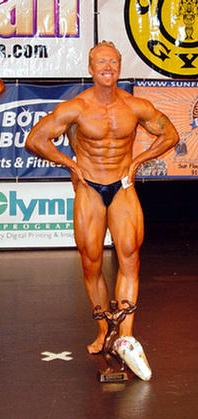
He may not actually be natural (getting around the drug testing in many “natural” federations is so easy it’s a joke), but I think his legs represent a realistic ceiling for natural leg development.
Getting there–or anywhere close to there–just takes a bit of know-how, hard work, and patience. The strategy is simple enough:
1. Focus on lifting heavy weights in your leg workouts.
If you want your legs to get big and strong, you’ll want to focus on the 4 to 6 or 5 to 7 rep range.
2. Focus on the leg exercises that safely allow for progressive overload.
As a natural weightlifter, you can take this to the bank: if you don’t continue to get stronger, you won’t continue to get bigger.
The number one rule of natural muscle building is progressive overload, which means adding weight to the bar over time.
Well, certain exercises don’t lend themselves well to both heavy lifting and progressive overload. Leg extensions, for example, cause a lot of strain in the knees.
Another aspect of your leg training that you have to get right is volume, or the total amount of reps you do each week.
This is especially important when you’re doing a lot of heavy weightlifting because the general rule is this:
The heavier the reps, the fewer you can do each week.
Heavier weights necessitate more recovery, which means you can’t do as many every week without risking overtraining.
I’ve tried many different splits and frequency schemes and what I’ve found works best is in line two extensive reviews on the subject.
When your training emphasizes heavy weights (80 to 85%+ of 1RM), optimal volume seems to be about 60 to 70 reps performed every 5 to 7 days.
This not only applies to the legs but to every other major muscle group as well.
Alright, now that we have basic training theory under our belts, let’s look at the best leg exercises for building muscle and strength.
The Best Leg Exercises
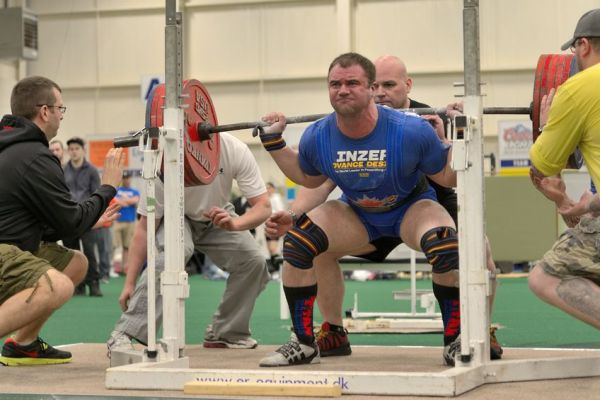
Like with most muscle groups, there are scores of leg exercises you can choose from but only a small handful are really necessary.
In fact, as you’ll see, the list of the best leg exercises is quite small: a few types of squats and lunges and a couple machines and that’s about it.
Before we look at them, though, let’s talk Smith Machines…
What About the Smith Machine?

When it comes to squatting, the main drawback of using the Smith Machine is it produces smaller gains in muscle and strength than the free weight squat.
One of the major reasons for this is the bar on the Smith Machine moves on a fixed, vertical movement path. The free weight bar, on the other hand, requires that you stabilize it to keep the bar level and prevent horizontal swaying.
I used to do all my squatting on the Smith Machine and never got higher than 235 pounds for a few reps. When I first switched to the free weight squat, I struggled with 185 pounds.
That was several years ago and I’ve since built my free weight back squat up to 365 pounds for 2 to 3 reps and my front squat up to 275 pounds for the same (not outstanding by any means but respectable and a work in progress!).
The Power Rack is your best friend.
A squat stand is fine if you have a spotter, but if you don’t, you’re probably not going to be able to push yourself as hard as you want for fear of getting stuck in the bottom of your squats.
Even if you have a lot of weightlifting experience and a good feel for your body and when you’re going to fail, there are going to be times where you either could have squeezed out another rep but didn’t go for it or where you do go for it and get stuck.
Enter the Power Rack. Here’s a fantastic one made by Rogue, which I highly recommend:
The safety arms are what make it so useful. Set them at the right height and they will catch the weight when you fail. Here’s how to do it:
Alright then.
Let’s now review the leg exercises that I recommend.
1. Barbell Back Squat
No surprise here, of course.
The barbell back squat is hands down the most effective leg exercise you can do for building overall size and strength.
Many people think of it as just a leg exercise but it’s much more than that–it’s a whole-body exercise, really, because it engages most major muscle groups.
It must be performed correctly, however. Bad squat form not only makes the exercise less effective, it increases the risk of injury.
Here’s a great video that breaks it all down:
Before we move on to the next exercise, let’s take a minute to talk the full squat (or “Ass to Grass” squat as the cool kids like to say).
First, here’s what it looks like:
While there are benefits to the full squat (it makes the legs, and butt in particular, do more work), it requires quite a bit of mobility and flexibility–more than most people have.
It’s for this reason that I don’t recommend full squatting unless you’re an experienced weightlifter that a) knows proper form (with special attention given to preventing excessive buttwinking) and b) is flexible enough to “ATG” properly.
If that’s not you, work with the parallel squat instead and you’ll do great. Full squatting is not necessary for building a big, strong posterior chain.
Now, before we move on, let’s talk a little more about how lower body flexibility and mobility affects your ability to squat safely, heavily, and properly.
Lack of hip flexibility is probably the most common problem that prevents people from squatting properly, but hamstring tightness and even calf and ankle stiffness can cause problems as well.
Fortunately, you can fix and prevent these issues fairly easily using this squat mobility routine.
2. Barbell Front Squat
The barbell front squat is, by far, my second favorite legs exercise.
Research shows that the front squat emphasizes the quadriceps more than the back squat (which involves more hamstring), but it also places less stress on the knees and lower back, making it ideal for people struggling with back or knee problems.
Here’s how to do it:
Yes, this feels quite awkward and uncomfortable at first, but the more you do it, the better it gets.
When I started front squatting, 135 pounds actually kind of hurt my shoulders. Now I’m up to 275 pounds without even slight discomfort.
3. Barbell Lunge
Although the lunge is generally thought of as a quadriceps exercise, research shows it relies more on the hamstring and glutes.
Nevertheless, it’s a worthwhile inclusion in your leg workouts.
Here’s how to do it:
4. Romanian Deadlift
The Romanian deadlift, or RDL, is one of my favorite exercises for targeting the muscles of the hamstring.
Here’s how it works:
5. Bulgarian Split Squat
You don’t see many people at the gym doing Bulgarian split squats but it’s not some random “foo-foo” exercise.
In fact, the split squat is quickly becoming more and more popular among high-level strength and conditioning coaches, and for good reason.
Research suggests the split squat may be as effective at increasing back squat one-rep max as the back squat itself while placing less strain on the lower back.
Furthermore, it differs from the front squat in that it more heavily involves the hamstrings.
6. Hack Squat Sled
While I’m generally not a fan of machines, I like the hack squat sled for emphasizing the quadriceps.
Like front and split squats, it’s an effective way to train the legs and hips while minimizing stress on the lower back.
7. Leg Press Machine
The leg press is another worthwhile machine for leg training and for building quadriceps strength in particular.
There are two types of leg press machines found in most gyms, though.
One has you seated more or less upright, pressing the weight straight out and back:
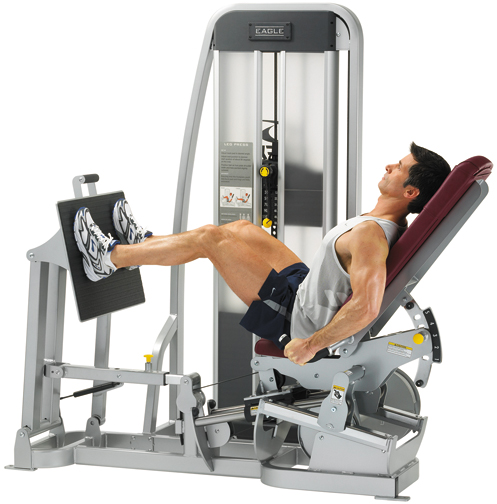
And the other has you seated, pressing the weight up at a 45-degree angle:
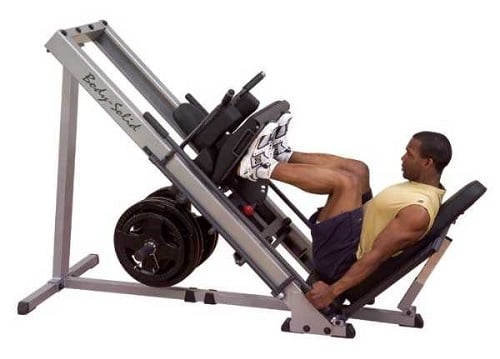
I much prefer the latter as it allows for a fuller range of motion. Here’s how to do it:
8. Hip Thrust
While this exercise looks silly, it’s one of the best exercises you can do for your glutes.
It can be performed without weight:
Or with weight:
9. Standing Calf Raise
This simple exercise is a tried-and-true calf builder.
10. Seated Calf Raise
This is a worthwhile variant of the calf raise.
I like that it doesn’t place any stress on the lower back as you get into heavier loads.
11. Calf Raise on the Leg Press
This is another good calf raise variant that I like to include in my leg routines.
Remember–Progression is the Key to Muscle Growth
That’s it for the best leg exercises.
The key, however, isn’t just doing the exercises–it’s progressing on them. That is, increasing the amount of weight you can move over time.
If you don’t get stronger, you won’t get bigger.
But if you do work on building your strength on these exercises, and you eat enough food to grow, your legs will respond.
The Ultimate Leg Workout
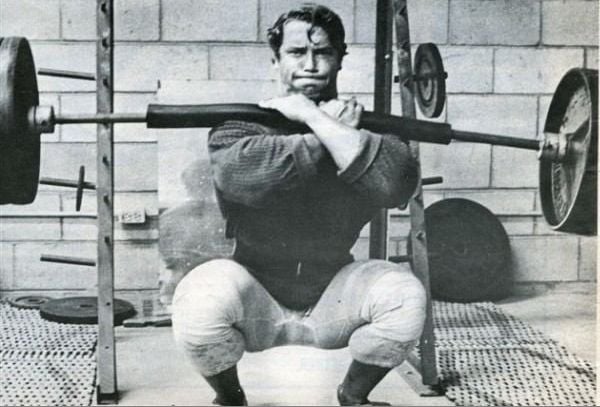
A good leg workout trains both the quadriceps and hamstrings and focuses on heavy, compound movements. It can also include glute- and calf-specific training if necessary.
Just like any other muscle group, the legs can benefit from higher rep work, but you have to emphasize the heavy weightlifting if you want them to continue to grow over time.
You can learn more about programming workouts in my books Bigger Leaner Stronger and Thinner Leaner Stronger, but I want to give you a simple leg workout that you can do for the next 8 weeks to see how my advice works for you.
What I want you to do over the next 8 weeks is perform the following leg workout once every 5 – 7 days:
Barbell Back Squat
Warm up and 3 sets of 4 to 6 reps (men) or 8 to 10 reps (women)
Front Squat
3 sets of 4 to 6/8 to 10 reps
Bulgarian Split Squat
3 sets of 4 to 6/8 to 10 reps
Optional
Hip Thrust
3 sets of 8 to 10 reps
Optional
Standing Calf Raise
3 sets of 8 to 10 reps
That’s it–just 9 heavy sets for the hamstrings and quads plus optional glute and calf training.
- Rest 3 minutes in between each set.
This will give your muscles enough time to fully recoup their strength so you can give maximum effort each round.
- Once you hit the top of your rep range for one set, you move up in weight.
For instance, if you get 6 reps on your first set of squats, you add 5 pounds to each side of the bar for your next set and work with that weight until you can (eventually) squat it for 6 reps, and so forth.
I guarantee that if you do this workout and eat right for the next 8 weeks, you’ll be very happy with how your lower body responds.
What About Supplements?

I saved this for last because, quite frankly, it’s far less important than proper diet and training.
You see, supplements don’t build great physiques–dedication to proper training and nutrition does.
Unfortunately, the workout supplement industry is plagued by pseudoscience, ridiculous hype, misleading advertising and endorsements, products full of junk ingredients, underdosing key ingredients, and many other shenanigans.
Most supplement companies produce cheap, junk products and try to dazzle you with ridiculous marketing claims, high-profile (and very expensive) endorsements, pseudo-scientific babble, fancy-sounding proprietary blends, and flashy packaging.
So, while workout supplements don’t play a vital role in building muscle and losing fat, and many are a complete waste of money…the right ones can help.
The truth of the matter is there are safe, natural substances that have been scientifically proven to deliver benefits such as increased strength, muscle endurance and growth, fat loss, and more.
As a part of my work, it’s been my job to know what these substances are, and find products with them that I can use myself and recommend to others.
Finding high-quality, effective, and fairly priced products has always been a struggle, though.
That’s why I took matters into my own hands and decided to create my own supplements. And not just another line of “me too” supplements–the exact formulations I myself have always wanted and wished others would create.
I won’t go into a whole spiel here though. If you want to learn more about my supplement line, check this out.
For the purpose of this article, let’s just quickly review the supplements that are going to help you get the most out of your leg (and other) workouts.
Creatine
Creatine is a substance found naturally in the body and in foods like red meat. It’s perhaps the most researched molecule in the world of sport supplements–the subject of hundreds of studies–and the consensus is very clear:
Supplementation with creatine helps…
You may have heard that creatine is bad for your kidneys, but these claims have been categorically and repeatedly disproven. In healthy subjects, creatine has been shown to have no harmful side effects, in both short- or long-term usage. People with kidney disease are not advised to supplement with creatine, however.
If you have healthy kidneys, I highly recommend that you supplement with creatine. It’s safe, cheap, and effective.
In terms of specific products, I use my own, of course, which is called RECHARGE.
RECHARGE is 100% naturally sweetened and flavored and each serving contains:
- 5 grams of creatine monohydrate
- 2100 milligrams of L-carnitine L-tartrate
- 10.8 milligrams of corosolic acid
This gives you the proven strength, size, and recovery benefits of creatine monohydrate plus the muscle repair and insulin sensitivity benefits of L-carnitine L-tartrate and corosolic acid.
Protein Powder
You don’t need protein supplements to gain muscle, but, considering how much protein you need to eat every day to maximize muscle growth, getting all your protein from whole food can be impractical.
That’s the main reason I created (and use) a whey protein supplement. (There’s also evidence that whey protein is particularly good for your post-workout nutrition.)
WHEY+ is 100% naturally sweetened and flavored whey isolate that is made from milk sourced from small dairy farms in Ireland, which are known for their exceptionally high-quality dairy.
I can confidently say that this is the creamiest, tastiest, healthiest all-natural whey protein powder you can find.
Pre-Workout Drink
There’s no question that a pre-workout supplement can get you fired up to get to work in the gym. There are downsides and potential risks, however.
Many pre-workout drinks are stuffed full of ineffective ingredients and/or minuscule dosages of otherwise good ingredients, making them little more than a few cheap stimulants with some “pixie dust” sprinkled in to make for a pretty label and convincing ad copy.
Many others don’t even have stimulants going for them and are just complete duds.
Others still are downright dangerous, like USPLabs’ popular pre-workout “Jack3d,”which contained a powerful (and now banned) stimulant known as DMAA.
Even worse was the popular pre-workout supplement “Craze,” which contained a chemical similar to methamphetamine.
The reality is it’s very hard to find a pre-workout supplement that’s light on stimulants but heavy on natural, safe, performance-enhancing ingredients like beta-alanine, betaine, and citrulline.
And that’s why I made my own pre-workout supplement. It’s called PULSE and it contains 6 of the most effective performance-enhancing ingredients available:
- Caffeine. Caffeine is good for more than the energy boost. It also increases muscle endurance and strength.
- Beta-Alanine. Beta-alanine is a naturally occurring amino acid that reduces exercise-induced fatigue, improves anaerobic exercise capacity, and can accelerate muscle growth.
- Citrulline Malate. Citrulline is an amino acid that improves muscle endurance, relieves muscle soreness, and improves aerobic performance.
- Betaine. Betaine is a compound found in plants like beets that improves muscle endurance, increases strength, and increases human growth hormone and insulin-like growth factor 1 production in response to acute exercise.
- Ornithine. Ornithine is an amino acid found in high amounts in dairy and meat that reduces fatigue in prolonged exercise and promotes lipid oxidation (the burning of fat for energy as opposed to carbohydrate or glycogen).
- Theanine. Theanine is an amino acid found primarily in tea that reduces the effects of mental and physical stress, increases the production of nitric oxide, which improves blood flow, and improves alertness, focus, attention, memory, mental task performance, and mood.
And what you won’t find in PULSE is equally special:
- No artificial sweeteners or flavors..
- No artificial food dyes.
- No unnecessary fillers, carbohydrate powders, or junk ingredients.
The bottom line is if you want to know what a pre-workout is supposed to feel like…if you want to experience the type of energy rush and performance boost that only clinically effective dosages of scientifically validated ingredients can deliver…then you want to try PULSE.
Want More Workouts?
The Ultimate Chest Workout
The Ultimate Arms Workout
The Ultimate Back Workout
The Ultimate Shoulder Workout
The Ultimate Abs Workout
The Ultimate Legs Workout
The Ultimate Calves Workout
The Ultimate Butt Workout
The Ultimate Forearm Workout
The Ultimate Bodyweight Workout
What do you think of these leg exercises? Have anything else you’d like to share? Let me know in the comments below!
+ Scientific References
- Stokes, T., Hector, A. J., Morton, R. W., McGlory, C., & Phillips, S. M. (2018). Recent perspectives regarding the role of dietary protein for the promotion of muscle hypertrophy with resistance exercise training. In Nutrients (Vol. 10, Issue 2). MDPI AG. https://doi.org/10.3390/nu10020180
- Helms, E. R., Aragon, A. A., & Fitschen, P. J. (2014). Evidence-based recommendations for natural bodybuilding contest preparation: Nutrition and supplementation. In Journal of the International Society of Sports Nutrition (Vol. 11, Issue 1, p. 20). BioMed Central Ltd. https://doi.org/10.1186/1550-2783-11-20
- Wojtys, E. M., Huston, L. J., Taylor, P. D., & Bastian, S. D. (1996). Neuromuscular adaptations in isokinetic, isotonic, and agility training programs. American Journal of Sports Medicine, 24(2), 187–192. https://doi.org/10.1177/036354659602400212
- Arendt, E., & Dick, R. (1995). Knee Injury Patterns Among Men and Women in Collegiate Basketball and Soccer: NCAA Data and Review of Literature. The American Journal of Sports Medicine, 23(6), 694–701. https://doi.org/10.1177/036354659502300611
- Holcomb, W. R., Rubley, M. D., Lee, H. J., & Guadagnoli, M. A. (2007). Effect of hamstring-emphasized resistance training on hamstring:quadriceps strength ratios. Journal of Strength and Conditioning Research, 21(1), 41–47. https://doi.org/10.1519/R-18795.1
- Yanagisawa, O., & Fukutani, A. (n.d.). Section I-Kinesiology Muscle Recruitment Pattern of The Hamstring Muscles in Hip Extension and Knee Flexion Exercises. Journal of Human Kinetics, 72(2020), 51–59. https://doi.org/10.2478/hukin-2019-0124
- Alkjær, T., Wieland, M. R., Andersen, M. S., Simonsen, E. B., & Rasmussen, J. (2012). Computational modeling of a forward lunge: Towards a better understanding of the function of the cruciate ligaments. Journal of Anatomy, 221(6), 590–597. https://doi.org/10.1111/j.1469-7580.2012.01569.x
- Krause Neto, W., Soares, E. G., Vieira, T. L., Aguiar, R., Chola, T. A., Sampaio, V. de L., & Gama, E. F. (2020). Gluteus maximus activation during common strength and hypertrophy exercises: A systematic review. In Journal of Sports Science and Medicine (Vol. 19, Issue 1, pp. 195–203). Journal of Sport Science and Medicine. http://www.jssm.org


